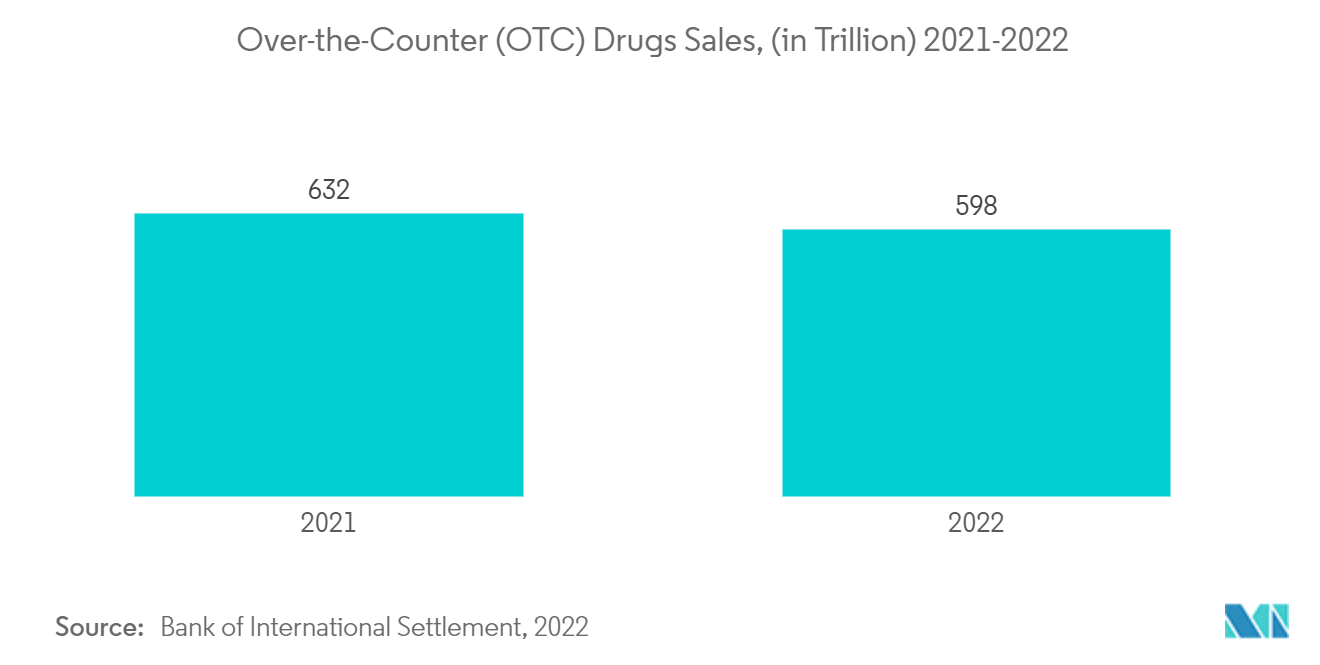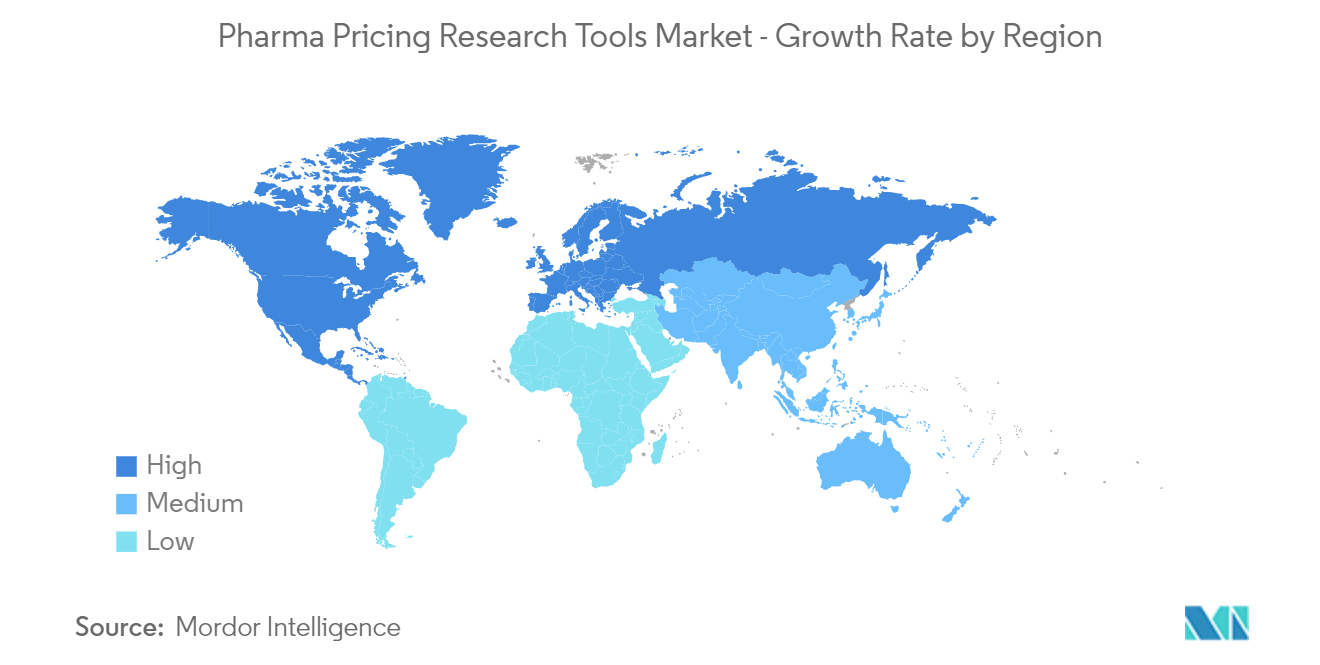Market Trends of Pharma Pricing Research Tools Industry
The Over-the-Counter Segment is Expected to Show Healthy Growth Over the Forecast Period
Over-the-counter (OTC) medications are more convenient to procure than prescription drugs because of their affordability, ease of production, and lenient regulatory scenarios. This makes them more attractive for early-stage research and testing of pricing strategies. Most people generally opted OTC drugs due to their less expensive and easy affordability. For instance, according to data published by KFF's Health Tracking in January 2023, 85% of adults reported using healthcare insurance to pay for their prescription drugs, and 1 in 5 adults reported difficulty affording needed prescription medicines. This approach leads to the demand for OTC drugs, further boosting the demand for the pharma pricing research tools market in the forecast period.
Over-the-counter drugs are readily available in the market, and direct consumer feedback on pricing sensitivity allows pharmaceutical companies to evaluate the different pricing models in real-time and adjust their strategies accordingly. Increasing pressure for pricing transparency from regulators and consumers requires companies to justify their OTC pricing strategies, further highlighting the need for robust research tools. For instance, according to European Union Law in October 2023, EMIR establishes regulations for over-the-counter (OTC) derivative contracts, central counterparties (CCPs), and trade repositories, aligning with G20 commitments made in Pittsburgh, United States. Increased pressure on drug manufacturers to comply with complex and involving pricing regulations creates a demand for specialized tools and expertise that will further increase the market expansion in the forecast period.
Emerging technologies like AI and big data analytics are transforming the OTC pricing landscape. Companies utilize these tools to gain deeper insights and make more informed pricing decisions. For instance, according to DataToBiz, in May 2023, statistics show that the pharma industry will spend around USD 3 billion on AI in drug discovery by 2025. These tools can provide valuable insights into consumer behavior, competitor pricing, and market trends, helping manufacturers make informed pricing decisions. These emerging technologies to develop software will expand the market in the forecast period.
Hence, market forces like rising price sensitivity and AI-driven analytics are expected to continue to grow in the coming years.

North America is Expected to Show Significant Share in the Market Over the Forecast Period
North America is expected to hold a significant market due to rising R&D expenditure, high drug cost burden, and strict regulations. North American pharmaceutical companies invest heavily in R&D, leading to frequent drug launches and complex pricing considerations. Research tools are crucial for managing diverse pricing strategies across various drugs. Additionally, North America has stringent regulations around pharmaceutical pricing and drug marketing. Regulations promoting value-based pricing, where reimbursement is linked to therapeutic outcomes, require robust analytics to assess real-world effectiveness and cost-effectiveness. This fuels the demand for advanced pricing research tools.
Companies require advanced research tools to navigate these complexities and ensure compliance with legal requirements. Regulatory bodies in North America increasingly emphasize pricing transparency, necessitating robust research tools for companies to analyze, justify, and communicate their pricing strategies. The United States drug pricing and reimbursement are undergoing significant changes, with federal legislation and the prescription drug pricing reform provisions of the Inflation Reduction Act significantly altering the pricing regime under certain federal programs. For instance, in an article published by Pharmacy Journal (MDPI) in October 2023, the Inflation Reduction Act of 2022 (IRA) poses a significant challenge to the profitability of select drugs for United States pharmaceutical companies. The act empowers Medicare to negotiate prices directly and mandates rebates for excessive price increases, compressing profit margins on affected products. The IRA includes provisions that aim to lower medicare drug prices, including allowing negotiations for certain high-cost drugs and certain high-cost drugs and requiring manufacturers to deduct excessive price increases. The law allows Medicare to negotiate prices on selected drugs and requires pharmaceutical companies to rebate price increases exceeding inflation. Hence, IRA's price negotiation and inflation rebates introduce complexities in drug pricing. This, in turn, fuels the demand for pharma pricing research tools. These tools become crucial for navigating the new landscape and making informed decisions about drug costs.
Canadians are struggling to afford medications due to high drug prices. This puts pressure on the healthcare system. Pharma pricing research tools can help find more affordable treatment options. This raises demand for transparency and fairer pricing, putting pressure on manufacturers to justify their pricing decisions. Government agencies like the Patented Medicine Prices Review Board (PMPRB) are implementing stricter regulations and price controls to address public concerns. For instance, in data published by the Government of Canada in May 2023, Prince Edward Island (PEI) expanded its provincial drug coverage to reduce copays for almost 60% of medications regularly used by Island residents and increase access to the provincial High-Cost Drug Program. This program reduces copays for commonly prescribed, eligible medications to USD 5 for residents covered under the seniors drug, the family health benefit, as well as the generic drug and diabetes drug programs. This includes medications used to manage mental health, cardiovascular disease, and diabetes and represents about 60% of prescriptions that Island residents use regularly. The rising cost burden of the drug class creates a complex situation for pharma companies, which will further need specialized pricing tools to lower drug prices and increase the market's growth.
Therefore, the aforementioned factors, like the rising cost of drugs and strict regulations by the government for drug approval in the market, are anticipated to fuel the market's growth over the forecast period.


